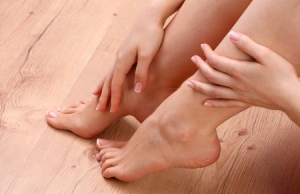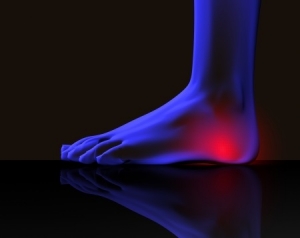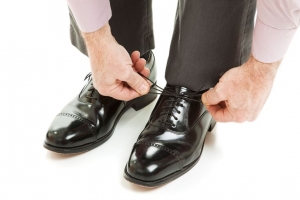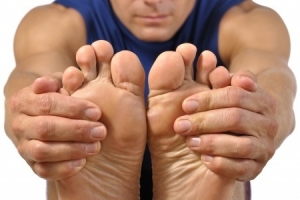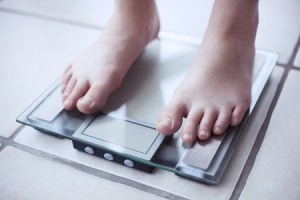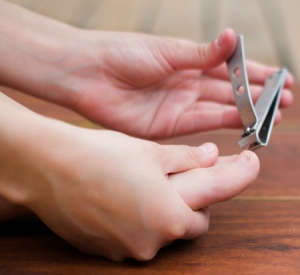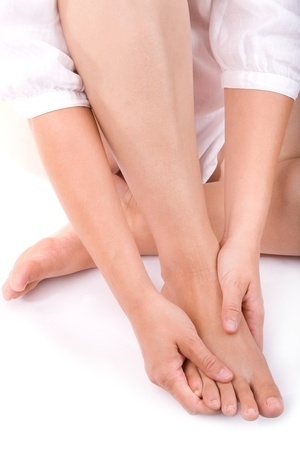Connect With Us
Blogs
Displaying items by tag: plantar fasciitis
Foot Problems Caused by Staying at Home
At Superior Foot & Ankle Care we’ve seen an increase in foot pain among our Los Angeles County patients in recent months. For many, this is the result of the shutdown due to the pandemic. Many people have had their normal fitness routine interrupted. In addition, a simple at-home habit has had a surprising consequence. Going barefoot or wearing slippers or flip-flops around the house may be normal after work—but what about when you don’t leave the house to go to work? The increased amount of time in this type of footwear leads to several common conditions including:
- Flat feet
- Heel pain and plantar fasciitis
- Arch pain
Re-Entering an Active Lifestyle
As you begin to get back to your normal routine there are some steps you can take to help ease the transition and reduce foot discomfort.
- Wear good quality, supportive shoes, even when home. The trouble with going barefoot is that the arch of the foot is not supported. As your arch flattens, it puts strain on the plantar fascia (the long band of tissue that stretches across the bottom of your foot). This can cause both arch and heel pain. A cushioned insole is also helpful in preventing podiatric pain.
- Change positions frequently. Working from home means you’re not even walking to the car or going out at lunch. Be sure to get up at least once an hour if you’re sitting at a desk or try standing to work if you can find a counter that is the correct height. Stretch and rotate your feet and wiggle your toes throughout the day to stay flexible and keep up good circulation.
- Gradually increase activity. While it may be tempting to jump into an exercise program at full speed, it’s better to start slowly. You’re more prone to injuries if you try to push your body too far too fast after a period of being inactive. Walking is a great way to re-enter a more active lifestyle. Try fitting in a walk during lunch or at the end of the workday.
If you’re experiencing foot pain that you can’t explain or you start to have uncomfortable symptoms in your feet or ankles as you become more active, contact our Long Beach office at (562) 420-9800 and schedule an appointment with our podiatrists, Dr. Victoria M. Foley and Dr. Constance Ornelas.
Keep it Moving for a Healthy Heart
February is American Heart Month and at Superior Foot & Ankle Care Center we know that your feet and your heart have a loving relationship. A healthy heart means good circulation which is beneficial to your feet. Your feet play an important role in a key element of heart health: staying active. We want our Los Angeles County patients to know that regular physical activity is one of the best ways to reduce your risk of heart disease. The American Heart Association recommends adults get in 150 active minutes (2.5 hours) each week. In addition to keeping your heart healthy, there are other benefits of an active lifestyle including:
- Reduced risk of other diseases such as stroke, diabetes, high blood pressure, dementia, and several types of cancer
- Help with weight loss or maintaining an appropriate weight
- Better sleep
- Less anxiety and depression
- Improved bone strength and balance, which decreases fall risk
- Mental sharpness: improved cognition, attention, processing, and memory
Help Your Feet Help Your Heart
For your feet to be able to help you stay active, they too need care and attention. Follow these tips to ensure that your feet and ankles are in tip-top shape for physical activity.
Take Care of Foot Pain—continuing to work out if your feet or ankles hurt is a bad idea. Any podiatric discomfort should be evaluated by our podiatrists, Dr. Victoria M. Foley and Dr. Constance Ornelas. The foot doctor will examine your feet and diagnose any problems that will impede your ability to be active. Your podiatrist can also make recommendations to help you accommodate chronic foot problems like plantar fasciitis and bunions. Shoe modifications, custom orthotics, and other recommendations can help. Make an appointment by contacting our Long Beach office at (562) 420-9800.
Choose Shoes Wisely—what you wear on your feet can have a big impact on the success of any fitness regimen. Be sure the athletic footwear you are using is the right kind for the activity you’ve chosen. Check shoes regularly for signs of wear such as compacted insoles, worn down heels, and rips or tears. Get your feet professionally measured to ensure you’re wearing the correct size.
Mix Up Your Routine—choose a variety of different types of activity each week. A mix of aerobic and strength training will benefit your heart and avoiding repetitive strain and impact is good for your feet.
If you have additional questions about heart health, fitness, and your feet, contact us today.
Holiday Season Do’s and Don’ts for Healthy Feet
Although the radio may be proclaiming “It’s the Most Wonderful Time of the Year,” we at Superior Foot & Ankle Care Center know that the feet of our Los Angeles County patients may not agree. It’s a time of year with lots of extra errands to run, cooking and shopping to do, and being on your feet for longer periods than usual. However, you can sail through the season feeling “merry and bright” if you follow the do’s and don’ts below to keep your feet and ankles healthy and pain-free.
Do: go easy on holiday feasting. Yes, there will be lots of delicious sweets and treats on the menu, but come January extra weight gain could result in added stress and pain for your feet. Many common conditions such as plantar fasciitis, sesamoiditis, and metatarsalgia are all aggravated by carrying additional pounds. If you suffer with diabetes or gout, you need to pay particular attention to what you put on your plate. Go for small quantities of your favorites to savor and compensate by not loading up on unnecessary carbohydrates. Avoid going back for seconds!
Don’t: allow your feet to stay in damp socks. Whether you’ve stepped in a puddle or your feet are sweating during a long day of shopping, it’s essential to not let feet stay where it’s moist. Damp, dark, closed-in spaces (like the insides of your shoes) are the perfect breeding ground for fungal infections. Pack an extra pair of socks and change into them when you notice feet feel sweaty. Use foot powder before you put on socks.
Do: carefully consider footwear choices. When you know you’re going to be on your feet for several hours or doing an above-average amount of walking, make sure the styles you choose are comfortable and have good arch support and non-stick treads. Limit the amount of time in high-heeled party shoes!
Do: leave extra time in your schedule for making appointments. Rushing is when you’re most likely to not see an object in your path which can cause an ankle sprain or other injury.
Don’t: put off getting foot pain evaluated by our podiatrists, Dr. Victoria M. Foley and Dr. Constance Ornelas. This can result in a podiatric problem getting worse and potentially requiring longer and more invasive treatments. Make an appointment at our Long Beach office by calling: (562) 420-9800 today.
3 Common Causes of Heel Pain
One of the most frequent reasons that patients come to see us at Superior Foot & Ankle Care Center is heel pain. There are multiple causes of heel pain, however, and for that reason it’s important that if your heel is hurting, you have one of our podiatrists, Dr. Victoria M. Foley or Dr. Constance Ornelas examine your feet and determine the source of your discomfort. Once the foot doctor has diagnosed the condition that is causing your pain, the proper treatment plan can be decided upon.
Below are three common reasons heels hurt:
- Plantar Fasciitis—along the bottom of your foot there is a long band of tissue known as the plantar fascia that connects the heel bone to the ball of the foot. The plantar fascia is subject to large amounts of pressure and impact from normal daily activities. If you are a runner or serious athlete, your plantar fascia is getting an additional workout. When the plantar fascia becomes inflamed, it can cause heel pain. One telltale sign that plantar fasciitis is the cause of your heel discomfort is pain that is worse first thing in the morning. You may also experience pain in the arch of your foot and swelling on the bottom of your heel.
- Heel Spurs—spurs are outgrowths of bone. Heel spurs are often associated with, but are different from plantar fasciitis. When calcium deposits form in the heel, bone spurs can develop. Pressure from footwear and walking can cause redness, swelling, and painful inflammation. If you have heel spurs you may experience sharp pain or a dull ache.
- Flat Feet—although flat feet can also have several causes, the bottom line is that if your arch is collapsing, heel pain can result from it. Flattening of the arch puts your foot in a biomechanically abnormal position, which exerts excess pressure on the heel. This is why shoes that lack arch support can also be a heel pain trigger.
Depending on the source of your heel pain, there are many conservative treatments including: losing weight, custom orthotic and stretching exercises. Make an appointment at our Long Beach office in Douglas Park CA to find out why your heel is hurting.
Shoe Tips You Should Know
At Superior Foot & Ankle Care Center, our podiatrists, Dr. Victoria M. Foley or Dr. Constance Ornelas know that your shoes play a significant role in the health of your feet. Many common podiatric disorders can be caused or made significantly worse by wearing improper footwear. That’s why our podiatrists may ask you to bring the shoes you wear most often to our Long Beach office when you come for your appointment. If you have a chronic foot problem, talk to the foot doctor (contact us at 562-420-9800) about the best styles and brands of shoes for your particular condition. Below are some recommendations for choosing good shoes.
- Start by getting your foot measured by a professional. Some studies estimate that as many as 9 out of 10 people are wearing shoes that are too small for them. Foot size can change as you age.
- You should not be surprised if one of your feet measures larger than the other. This is true for most people. Always buy shoes that fit the bigger foot.
- Shop for shoes at the end of the day—that’s when your foot is at its largest and most swollen.
- Choose shoes with good arch support. This will help prevent heel pain and plantar fasciitis. Wearing shoes that are completely flat like flip-flops or ballet slippers greatly increases your risk of this condition.
- Cushioned and molded footbeds not only feel more comfortable, they act as shock absorbers, reducing the impact of your foot hitting the ground with each step you take.
- Wear the type of sock you will most likely use with the shoes you are buying. If the podiatrist has prescribed a custom orthotic, you also try it on with the shoes.
- Always try on both shoes and spend some time walking around the store to check for comfort and fit.
- Don’t buy shoes that pinch your feet or feel tight anywhere. There is no such thing as a “breaking in” period. Shoes should feel comfortable from the moment you leave the store.
4 Common Foot Problems for Men
June is a month for celebrating men! At Superior Foot & Ankle Care Center, we want to recognize Men’s Health Month by highlighting some foot infections that afflict men. Studies show that men are less likely to be proactive and diligent about getting medical care. Encourage the men you love to get foot problems treated promptly by our podiatrists, Dr. Victoria M. Foley or Dr. Constance Ornelas. Below are some common podiatric issues men face.
- Haglund’s Deformity—while this condition, known as “pump bump,” it frequently affects men as well as women. Haglund’s deformity is a bony enlargement at the back of the heel that can become inflamed and irritated from the friction of stiff dress shoes and other footwear rubbing up against it. Bursitis can also develop because of Haglund’s deformity. The foot doctor will recommend shoe modifications, including changes in style and heel lifts or pads to help reduce friction. Icing and anti-inflammatory medications may be prescribed to relieve initial pain and inflammation.
- Gout—this painful, arthritic condition that usually strikes the joint at the base of the big toe is seen most often in men, ages 40-60. It is caused by too much uric acid in the body, which crystallizes in the joint. There are several potential sources of gout, and the podiatrist will help men who have suffered a gout attack before tracking down the cause. In many cases, certain foods can trigger an attack, and gout patients may need to avoid shellfish, red meat, alcohol, and rich sauces.
- Fungal Infections—regular exercise is a key component of a healthy lifestyle, but if the gym or community pool is the work site of choice, it’s essential to keep feet covered to avoid fungal infections like athlete’s foot and fungal toenails. These are passed on by direct contact. Places where people usually are barefoot and that are moist and warm are prime breeding grounds.
- Plantar Fasciitis—one of the most frequent causes of heel pain is plantar fasciitis. The plantar fascia is a long band of tissue that stretches along the bottom of your foot. If it becomes inflamed, heel pain may result. Flat feet and poorly fitting or worn out shoes are one common cause of inflammation.
Encourage your man not to ignore foot and ankle pain. Instead, make an appointment at our Long Beach office today by calling: (562) 420-9800 and get treatment before the problem worsens.
Losing Weight: Your Feet Will Thank You
It’s a sad fact that 74% of overweight Americans have foot problems. So, while you may wonder what the connection is, at Superior Foot & Ankle Care Center, we know there is a direct correlation between being overweight or obese and the health of your feet. It’s easy to see when you stop and think about it: your feet are carrying the weight of your entire body—the more you weigh the more stress and hard work for your feet. Below are three benefits for your feet to losing weight:
- Less foot pain—excess weight puts strain on your tendons and joints and can cause a flattening of the arch of your foot. This can increase your risk or the severity of several foot conditions, including:
- Plantar fasciitis
- Tendonitis
- Arthritis
- Sesamoiditis
- Gout
Changes and discomfort in your feet can also lead to problems with your back, hips and knees. If you are experiencing pain in any part of your foot, it’s essential that you make an appointment at our Long Beach office by calling: (562) 420-9800 so that our podiatrists, Dr. Victoria M. Foley or Dr. Constance Ornelas can examine your feet and determine the source of your foot problem.
- Prevention of diseases—maintaining a healthy weight can also help lower your risk of certain medical conditions such as diabetes, hypertension and peripheral arterial disease. These systemic diseases can have devastating affects on your feet like neuropathy and circulation problems.
- Greater mobility—the less you weigh, the easier it is to be active. Being active can help in losing and maintaining a proper weight. A regular exercise routine will also help keep foot joints flexible and preserve a full range of motion.
The good news is that it doesn’t require a huge drop in weight to see big results for your feet. For example, for every pound you lose, this reduces the pressure on your knees by up to four pounds. If you are concerned that your weight may be affecting the condition of your feet, contact us today for more information.
10 Simple Steps to Healthier Feet
At Superior Foot & Ankle Care Center we want patients to know that being proactive about the health of your feet and ankles doesn’t have to be difficult or time consuming. April is National Foot Health Awareness Month and in its honor, we are providing these easy suggestions for taking care of your feet:
- Wash your feet every day with soap and warm water.
- Keep feet dry—change your socks if you sweat excessively. Dry between your toes after you shower. Dry feet are less likely to develop athlete’s foot.
- Don’t share shoes, socks, nail clippers, towels or other items that touch someone else’s feet.
- Inspect your feet regularly. Look for signs of foot disorders: swelling, redness, rashes, growths, lumps, discoloration of toenails and any cuts or wounds that are slow to heal.
- Don’t delay seeking treatment for foot and ankle pain. Most podiatric conditions will get worse the longer they go untreated. If you are experiencing foot pain or discomfort, make an appointment with our podiatrists, Victoria M. Foley or Dr. Constance Ornelas to get your condition evaluated as soon as possible.
- Get your foot measured professionally. Foot size can change during pregnancy and as you age. The majority of patients are wearing shoes that are too small for their feet.
- Wear shoes with good arch support. Many cases of heel pain and plantar fasciitis are caused by footwear that allows your arch to flatten, which in turn puts pressure on your heel.
- Stretch your feet. Flexing your feet, wiggling your toes and rotating your ankles all help keep feet flexible and promote good range of motion.
- Maintain a healthy weight. Many foot disorders are caused or made worse by being overweight.
- Apply sunscreen to your feet when they will be exposed—this means when you’re wearing sandals and open shoes as well as when you’re spending a day at the beach or pool.
Following these small steps will have a big impact on the health of your feet. To learn more about how to be proactive in the care of your feet, contact our Long Beach office by calling: (562) 420-9800.
5 Tips for Overworked Feet
Do you have an occupation that requires you to be on your feet for long hours at a time? At Superior Foot & Ankle Care Center we find that nurses, teachers, construction workers and other patients with jobs that have them upright and mobile for most of the day are more likely to have foot pain and swelling and are also at a higher risk for developing podiatric disorders. Although we can’t change your job, we can offer suggestions for ways to minimize foot pain and increase your comfort level.
Get Problems Checked Out Promptly
- The majority of foot problems, such as plantar fasciitis, sesamoiditis, flat feet and metatarsalgia, are made worse by being on your feet for extended periods of time. For this reason, if your work requires this, it’s particularly important to not put off getting foot problems evaluated. Our podiatrists, Dr. Victoria Foley and Dr. Constance Ornelas will examine your feet to determine the cause of your symptoms and recommend the best treatment. The foot doctor may be able to suggest padding or an orthotic device for your shoes to help relieve foot pain. Be sure to let the podiatrist know that you have a job that requires you to spend long hours on your feet.
Choose Shoes Wisely
- Your shoe choice is critical for comfort and protection. Choose styles with good ankle and arch support and a cushioned insole. It’s a good idea to alternate your shoes as well for maximum comfort and to avoid excess pressure to one particular spot on your foot.
Stay Hydrated
- Although it may seem backwards, drinking plenty of water is one of the best ways to prevent painful edema or swelling of your feet and ankles.
Make the Most of Break Time
- When you do get a break, get off your feet for as long as you can and elevate them if possible. Do some stretching exercises and flex your feet and toes. Once your break is over, try to change your position frequently. If you are unable to sit down, at least shift your weight from foot to foot.
Compensate During Non-Work Hours
- Be sure to put your feet up when you get home from work. Choose exercise and fitness activities that don’t put additional strain on your feet. Swimming, biking and rowing are examples of physical activities that don’t put more pressure on your feet. Be sure to soak your feet if they are sore and treat yourself to a foot massage now and then to relieve pain and stiff muscles.
If you have additional concerns about your feet and your occupation, contact our Long Beach office by calling: (562) 420-9800.
Good Eats to Help Your Feet
In March, we celebrate National Nutrition Month. At Superior Foot & Ankle Care Center we believe that good nutrition has many positive benefits for your podiatric health. What’s the connection between what you eat and your feet? Read on.
Maintain a Healthy Weight—one of the most obvious benefits to eating healthy is getting to and then maintaining a healthy weight. Being overweight increases the risk and severity of many foot health problems, including:
- Arthritis
- Plantar fasciitis
- Flat feet
- Sesamoiditis
Many patients may not realize when it comes to your lower extremities, the pressure of excess pounds can be dramatic. For example, every pound you gain or lose exacts 4 times the amount of pressure on your knees.
Stay Active—in addition to the fact that it’s easier to be active when you’re not overweight, the foods you eat can also impact your energy level. Avoiding processed foods and those high in saturated and trans fats and sugars and focusing on lean protein and complex carbohydrates can increase your energy level and help you be more active.
Get the Nutrients You Need—good nutrition is about eating a varied diet. Enjoying a rainbow of produce, both fruits and vegetables will ensure that your body gets all of the many nutrients it needs. Certain fruits and vegetables like blueberries and red peppers can help fight inflammation, a common source of pain in podiatric disorders. Making choices that ensure you get the calcium you need from dairy products, leafy greens, and certain fishes will build strong bones—something that’s important to your feet since over a quarter of all the bones in your body can be found there.
Avoid Diseases that Harm Your Feet—your diet can lower your risk for certain diseases like diabetes, heart disease, and high blood pressure. Each of these conditions causes problems that can harm your feet such as poor circulation and neuropathy.
If you have questions about ways that your diet can improve the health of your feet, contact our Long Beach office by calling: (562) 420-9800. Our podiatrists, Dr. Victoria Foley, and Dr. Constance Ornelas. We want to help our patients be proactive about their health and take the necessary steps to lead active lives.
